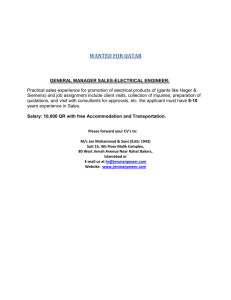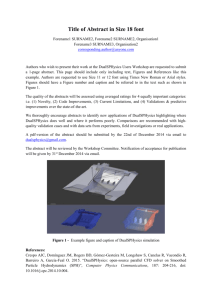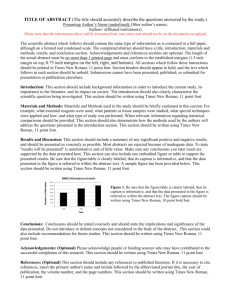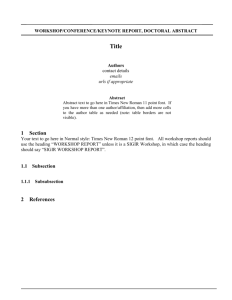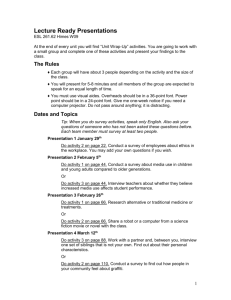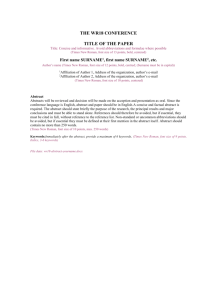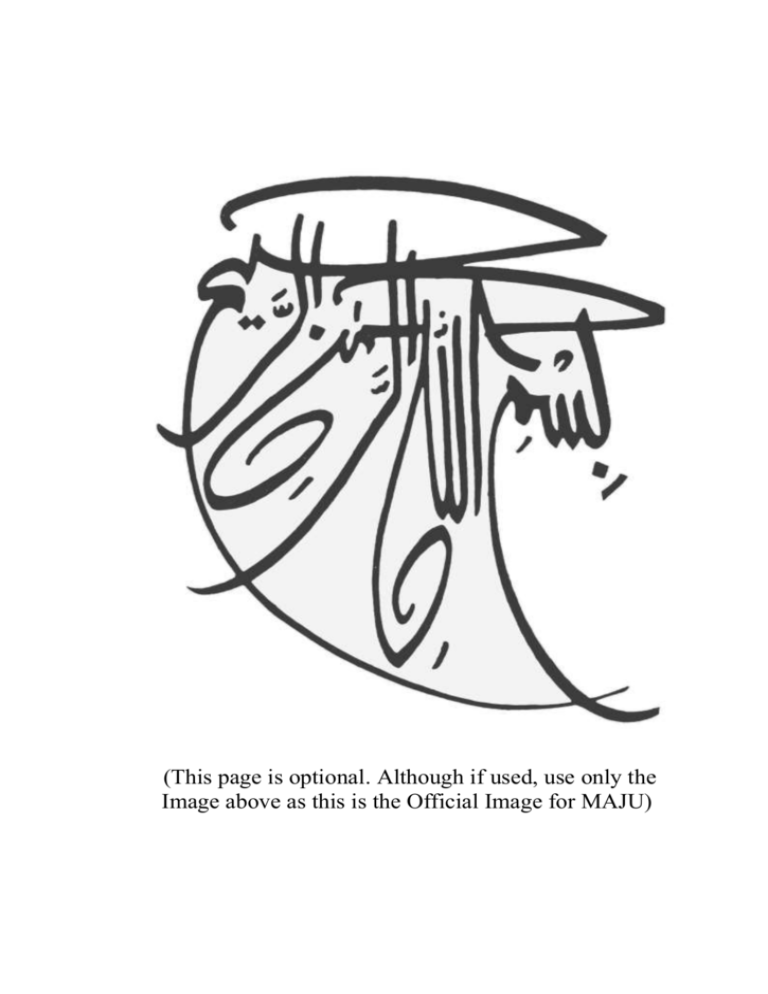
(This page is optional. Although if used, use only the
Image above as this is the Official Image for MAJU)
COMPLETE TITLE OF THE THESIS IN ALL
CAPS, TIMES NEW ROMAN, FONT SIZE 20
by
<Student Name> in font size 16
<Reg. No. XX> in font size 15
A thesis submitted to the
<Name of Department>
in partial fulfillment of the requirements for the degree of
MASTER OF SCIENCE IN ELECTRONIC ENGINEERING
[Font: Times New Roman, Size: 14]
Faculty of Engineering
Capital University of Science & Technology
Islamabad
<Month, Year>
[Font: Times New Roman, Size: 14]
Copyright 2010 by CUST Student
All rights reserved. Reproduction in whole or in part in any form requires the prior
written permission of <student name> or designated representative. [Font: Times New
Roman, Size: 12]
ii
This page should contain the dedication of the Project/Thesis. Try to be
as brief as possible in this dedication. Do not include half of world in the
dedication. [Font: Times New Roman, Size: 14, Italic]
(This page is optional)
iii
C ER TI FICA TE O F AP PROVA L
It is certified that the research work titled “Use of Open-Source platform in
Designing of Low Cost Prototype Wireless Sensor Mote” carried out by Abdul
Raheem, Reg. No. MT103039, under the supervision of Dr. Noor Muhammad
Khan, at Mohammad Ali Jinnah University, Islamabad Campus. It is fully adequate,
in scope and in quality, as a thesis for the degree of MS in Electronic Engineering.
Supervisor:
------------------------Dr. Noor M. Khan
Associate Professor
Department of Electronic Engineering
Mohammad Ali Jinnah University, Islamabad
Internal Examiner:
---------------------------Dr. Sajjad Hussain
Assistant Professor
Department of Electronic Engineering
Mohammad Ali Jinnah University, Islamabad
External Examiner:
---------------------------Dr. Moazzam Tiwana
Assistant Professor
Department of Electrical Engineering
COMSATS Institute of Information Technology, Islamabad
Dean:
---------------------------Dr. Amir Qayyum
Professor
Faculty of Engineering
Mohammad Ali Jinnah University, Islamabad
iv
ACKNOWLEDGMENT
This page is intended to thank your supervisor, co-supervisor and all those (students,
teachers, TA/SA or any third party) who directly helped you out in the completion of
the project/thesis. [Font: Times New Roman, Size: 12]
v
DECLARATION
It is declared that this is an original piece of my own work, except where
otherwise acknowledged in text and references. This work has not been submitted in
any form for another degree or diploma at any university or other institution for
tertiary education and shall not be submitted by me in future for obtaining any degree
from this or any other University or Institution.
[Font: Times New Roman, Size: 12]
<Name of Student 1>
<Reg. No. XYX>
<Name of Student 2 (if any)>
<Reg. No. XYZ>
Month Year (e.g. March 2010)
vi
ABSTRACT
The abstract is the most important part of a Thesis. Any abstract will be read
by ten or twenty times more than any other words in the Thesis. So, to make a
positive impression, or just convey information, here's where to really pay attention to
writing.
The purpose of abstract in not just to tell the reader about what was done: it is
to tell him/her what was done in the simplest, most informative way possible. Making
an abstract understandable for a non technical person should be the first priority.
Discussed below are the basic components of an abstract in any discipline and should
be handled in separate paragraphs.
First paragraph should be about Motivation/problem statement: Why do you
care about the problem? What practical, scientific, theoretical gap is your
research/project filling?
Methods/procedure/approach: What did you actually do to get your results?
(e.g. Designed something, developed your own algorithms/software/techniques, did
some survey, worked with some organization etc.)
Results/findings/product: As a result of completing the above procedure, what
did you learn/invent/create?
Conclusion/implications: What are the larger implications of your findings,
especially for the problem/gap identified in Motivation/problem statement paragraph?
vii
TABLE OF CONTENTS
Acknowledgment ..................................................................................................... v
Declaration .............................................................................................................. vi
Abstract. .................................................................................................................vii
Table of Contents ..................................................................................................viii
List of Figures .......................................................................................................... x
List of Tables .......................................................................................................... xi
List of Acronyms/Abbreviations............................................................................xii
Chapter 1
Introduction........................................................................................... 7
1.1
Overview ...................................................................................................... 7
1.2
Statement of Problem ................................................................................... 7
1.3
Purpose of the research/project .................................................................... 8
1.4
Applications of the research......................................................................... 8
1.5
Theoretical bases and organization .............................................................. 8
1.6
Summary ...................................................................................................... 8
Chapter 2
Literature review ................................................................................... 9
2.1
Related Technologies ................................................................................... 9
2.1.1
Related Technology 1 ................................................................... 9
2.1.2
Related Technology 2 ................................................................... 9
2.2
Related Projects ........................................................................................... 9
2.3
Related Studies............................................................................................. 9
2.3
Their Limitations and Bottlenecks ............................................................... 9
2.4
Summary ...................................................................................................... 9
Chapter 3
Tools and techniques …………......................................................... 10
3.1
Hardware used with complete technical specifications ............................. 10
3.2
Software(s), simulation tool(s) used .......................................................... 10
3.3
Summary .................................................................................................... 10
viii
Chapter 4
Methodologies and Implementation ................................................... 11
4.1
Design of the investigation ........................................................................ 11
4.2
Analysis procedures ................................................................................... 11
4.3
Implementation procedure ......................................................................... 11
4.3.1
Details about hardware ............................................................... 11
4.3.2
Details about software/ algorithms ............................................. 11
4.3.2
Details about control etc ............................................................. 11
4.4
Verification of functionalities .................................................................... 11
4.5
Details about simulation / mathmatical modeling ..................................... 11
4.6
Summary .................................................................................................... 11
Chapter 5
Results and Analysis ........................................................................... 12
5.1
5.2
Presentation of the findings ....................................................................... 12
5.1.1
Hardware results ......................................................................... 12
5.1.2
Software results ........................................................................... 12
Discussion of the findings .......................................................................... 12
5.2.1
Comparison with initial GOAL .................................................. 12
5.2.2
Reasoning for short comings ...................................................... 12
5.3
Limitations ................................................................................................. 13
5.4
Recommendations ...................................................................................... 13
5.5
Summary .................................................................................................... 13
Chapter 6
Conclusion .......................................................................................... 14
References........................................................................................... 15
Appendices(if included) ...................................................................... 16
Appendix - A.............................................................................................. 16
Appendix - B .............................................................................................. 17
ix
LIST OF FIGURES
Figure-1.1 Figure Caption ........................................................................................ 2
Figure-2.1 Figure Caption ........................................................................................ 4
Figure-2.2 Figure Caption ........................................................................................ 6
Figure-3.1 Figure Caption ........................................................................................ 8
x
LIST OF TABLES
Table-3.1 Caption of table ....................................................................................... 2
Table-3.2 Caption of table ....................................................................................... 2
Table-3.3 Caption of table ....................................................................................... 3
Table-4.1 Caption of table ....................................................................................... 4
xi
LIST OF ACRONYMS
MAJU
Mohammad Ali Jinnah University
FYP
Final Year Project
MS
Master of Science
MBA
Masters in Business Administration
HOD
Head of Department
xii

